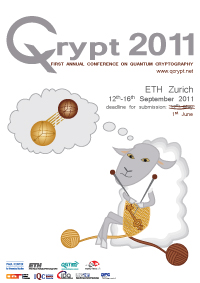|
|||||||||||
Higher-Dimensional Quantum Cryptography
Paul G. Kwiat, Kevin T. McCusker and Bradley Christensen (University of Illinois at Urbana-Champaign)
In the vast majority of quantum cryptography experiments to date, one generates at most one random key bit per photon (and strictly speaking, half a bit per photon is much more common). Here we present current progress on a scheme which will eventually enable us to achieve over 10 random key bits per detected photon. The essential idea is to use pulsed position modulation (ppm) in which a photon appears in one of, e.g., 1024 time bins, from which one can extract 10 bits of randomness. In our initial implementation, we used hyperentangled photons, in which the correlated timing of the photon pairs is used to generate key material, while the polarization entanglement is used to check for the presence of an eavesdropper.
Wichtiger Hinweis:
Diese Website wird in älteren Versionen von Netscape ohne
graphische Elemente dargestellt. Die Funktionalität der
Website ist aber trotzdem gewährleistet. Wenn Sie diese
Website regelmässig benutzen, empfehlen wir Ihnen, auf
Ihrem Computer einen aktuellen Browser zu installieren. Weitere
Informationen finden Sie auf
folgender
Seite.
Important Note:
The content in this site is accessible to any browser or
Internet device, however, some graphics will display correctly
only in the newer versions of Netscape. To get the most out of
our site we suggest you upgrade to a newer browser.
More
information







